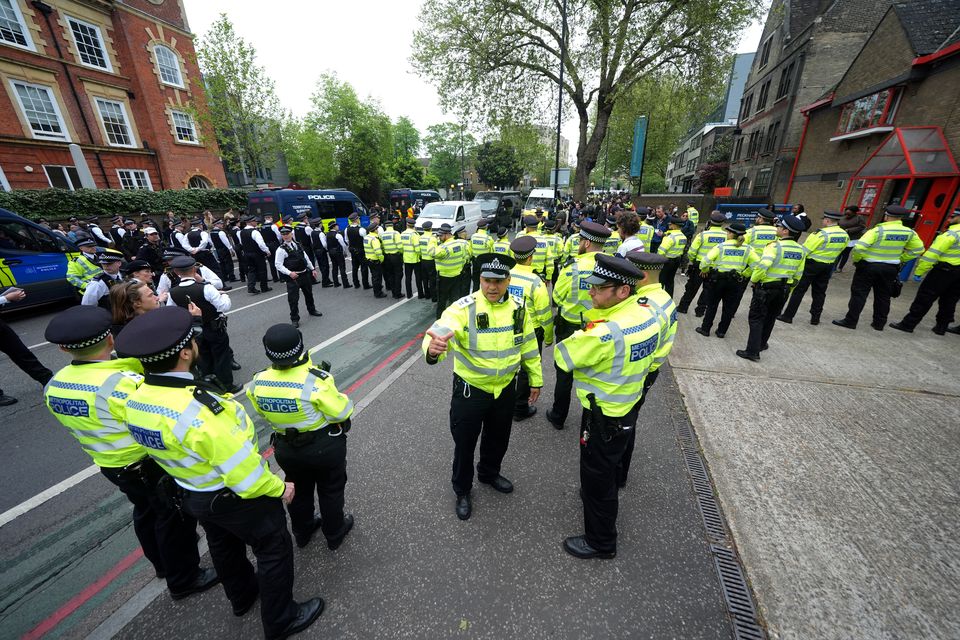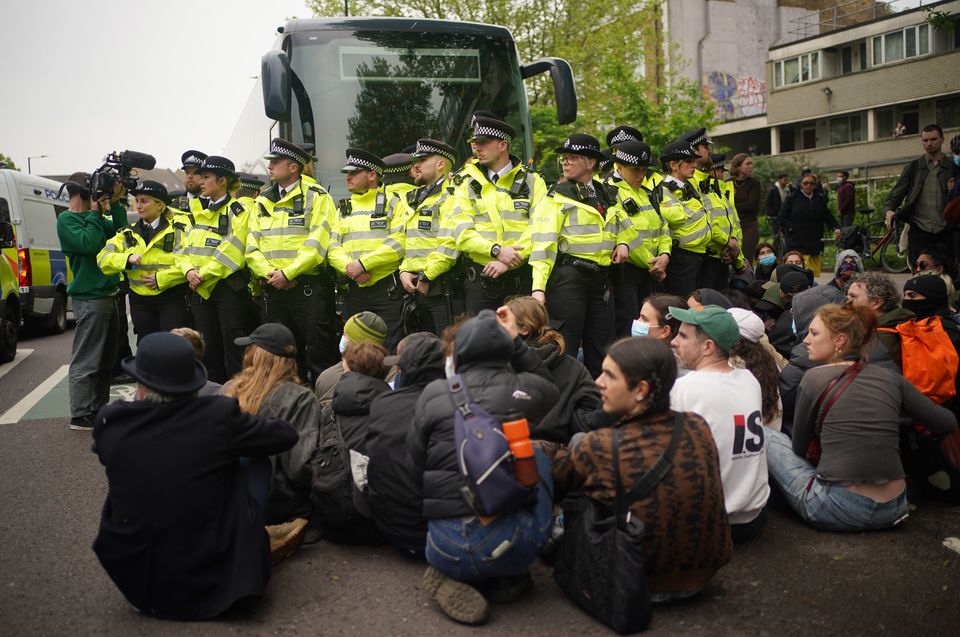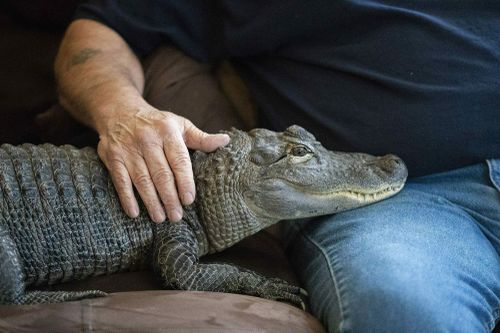UK police arrest 45 at protest against migrant removals
Police in London made 45 arrests on Thursday as protesters tried to stop the removal of migrants from their temporary accommodation, after the UK government began detaining people before controversial deportation flights to Rwanda.
Dozens of people surrounded a bus believed to be taking asylum seekers from a hotel in the Peckham area of south London to the Bibby Stockholm accommodation barge moored off the south coast of England.
Several other protests have been held or are planned around the country to stop immigration officers detaining migrants.
In Peckham, police moved in to disperse the protesters, who had formed a human chain around the bus and blocked the road in front of a hotel.
Most had their faces covered and hire bikes were put under the wheels of the bus, which reportedly had its tyres slashed or deflated.
Deputy Assistant Commissioner Ade Adelekan, from the Metropolitan Police, said officers were sent to remove people from the road.
“A total of 45 people have been arrested and taken into police custody for offences including obstruction of the highway, obstructing police and assault on police,” he said.
The bus left the scene without the seven migrants on board, according to protesters. Similar action in Margate, southeast England, on Wednesday also stopped migrants being taken to the Bibby Stockholm.
Interior minister James Cleverly was defiant and condemned those seeking to stop the removals.
“Housing migrants in hotels costs the British taxpayer millions of pounds every day,” he wrote on the social media platform X.
“We will not allow this small group of students, posing for social media, to deter us from doing what is right for the British public.”
Cleverly’s ministry this week confirmed that it has begun detaining asylum seekers before planned deportation to Rwanda, after parliament passed a law declaring it a safe country.
Several migrants were seen in photos and video footage released by the ministry being taken away in handcuffs by immigration officers.
– Channel crossings –
The ministry has not confirmed how many people have been held so far, but the government says it expects Rwanda to take 5,700 migrants this year.
The protests come after official figures published on Thursday showed that 711 people were brought ashore the previous day after trying to cross the Channel in small boats from northern France.
The number is the highest on a single day so far this year and comes even as London insists that its plan to “stop the boats” is working, including through the Rwanda deportation scheme.
The new high is more than the previous 2024 single-day record of 534 on April 14.
It takes the total number of migrants who have made the Channel crossing so far this year to 8,278 — up more than a quarter on the same period in 2023.
The highest-ever single-day arrivals figure was 1,295 and was recorded on August 22, 2022.
Prime Minister Rishi Sunak’s official spokesman said the figures demonstrated why the Rwanda plan was needed but the main opposition Labour party called it “unaffordable and unworkable”.
French police on Wednesday said they had rescued 66 people after their boat ran into trouble off the coastal town of Dieppe.
UK police have made several arrests as part of an investigation into the deaths of five people whose boat got into difficulties off the French coast on April 23.
Migration — both regular and irregular — has been a major political issue in the UK, given the government’s promise to tighten the country’s borders after leaving the European Union.
But doing so has proved a challenge, with the Conservative government desperate to trumpet successes as it goes into local elections on Thursday and a general election later this year.
Some 122,600 people have been intercepted in British waters and brought ashore since the UK began recording such arrivals in 2018.
by Henry NICHOLLS

Police try to stop protesters forming a blockade around a coach in Peckham (Yui Mok/PA)
By PA ReportersToday at 11:55
More than 40 people have been arrested after protesters blocked a coach set to take asylum seekers to the Bibby Stockholm barge.
Police said they were called at around 8.40am on Thursday to reports of people obstructing a coach, which was parked outside a Best Western Hotel in Peckham, south-east London.
A total of 45 people were arrested after officers were assaulted whilst trying to stop the protesters from obstructing the coach, the Metropolitan Police said.
A large group of people, many with their faces covered, surrounded the coach and were seen linking arms and sitting in Peckham Road.
Pictures showed lines of police officers attending the scene, while footage captured some jostling with protesters at one point.
The demonstrators could be heard chanting “no borders, no nations, stop deportations”, “say it loud, say it clear, refugees are welcome here”, and “when refugees are under attack, what do we do? Stand up, fight back”.
Deputy Assistant Commissioner Ade Adelekan said in a statement: “It saddens me greatly to say that a number of officers have been assaulted in the course of their duty following an incident in Peckham today where they sought to uphold the law.”

Police officers at the scene in Peckham (Yui Mok/PA)
He said that officers spoke to the coach driver and protesters “at length” and warned them that they could be arrested, and added: “After this demonstrators blocked the road and continued to prevent the coach, and police vehicles, from leaving.
“More officers were sent to the scene to safely remove people from the road, allow the vehicles to leave and for the road to reopen.
“A number of officers have reported being assaulted. Thankfully I’m glad that none of those are seriously hurt.”

Police remove a protester after demonstrators formed a blockade around the coach (Yui Mok/PA)
But protesters claimed police had been “pushing and shoving” peaceful demonstrators.
Laurence Smith, founder of the charity Lewisham Donation Hub, said two of his organisation’s volunteers, who are asylum seekers, had been threatened with being sent to the barge.
He told the PA news agency: “I came down today to make sure our volunteers left that hotel and went to the private accommodation that we found.”

Protesters formed a blockade around the coach which was set to take asylum seekers to the Bibby Stockholm barge (Yui Mok/PA)
He added that he had spoken to Superintendent Matt Cox, from the Metropolitan Police, at 10am to try to defuse the situation.
Jennie, 34, who did not want to give her surname, is a member of one of the groups who were involved in the protest.
She told PA: “We’re now trying to support the asylum seekers who weren’t removed.”
Jennie, who had visible cuts and bruises on her arms and hands, said police were “pushing and shoving” people and that she needed medical attention.
PA understands the asylum seekers were taken off the coach and have not yet left the hotel.
No amount of chanting, drum banging or tyre-slashing by a noisy few will prevent us doing what is necessary to deliver the firm but fair approach that the British people expectJames Cleverly, Home Secretary
The Home Office has not confirmed whether there are plans to try again to move the asylum seekers to the barge on another day or if the move had been abandoned, but Home Secretary James Cleverly said protests would not deter the “firm but fair approach the British people expect”.
He said: “We will continue to remove those with no right to be here, despite continued efforts by the Labour Party and a coalition of disparate student groups to stop us.
“No amount of chanting, drum banging or tyre-slashing by a noisy few will prevent us doing what is necessary to deliver the firm but fair approach that the British people expect.
“I’d like to thank the police for their swift and professional action. They have my full support in clamping down on unacceptable criminality, racism and intimidation regardless of where it comes from.”
It comes as the Home Office abandoned plans to move a group of asylum seekers to the barge in the wake of protests in Margate last week.











